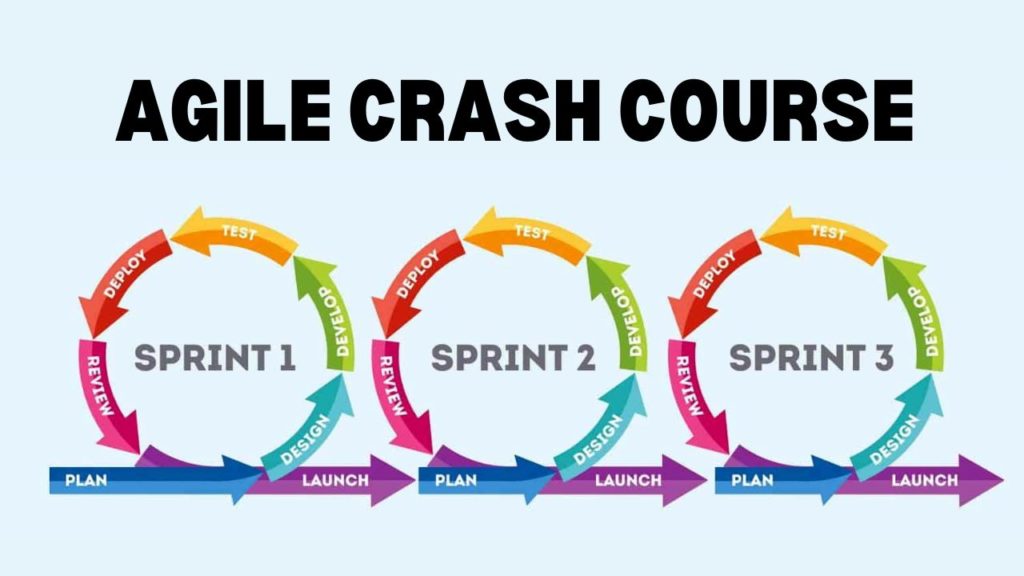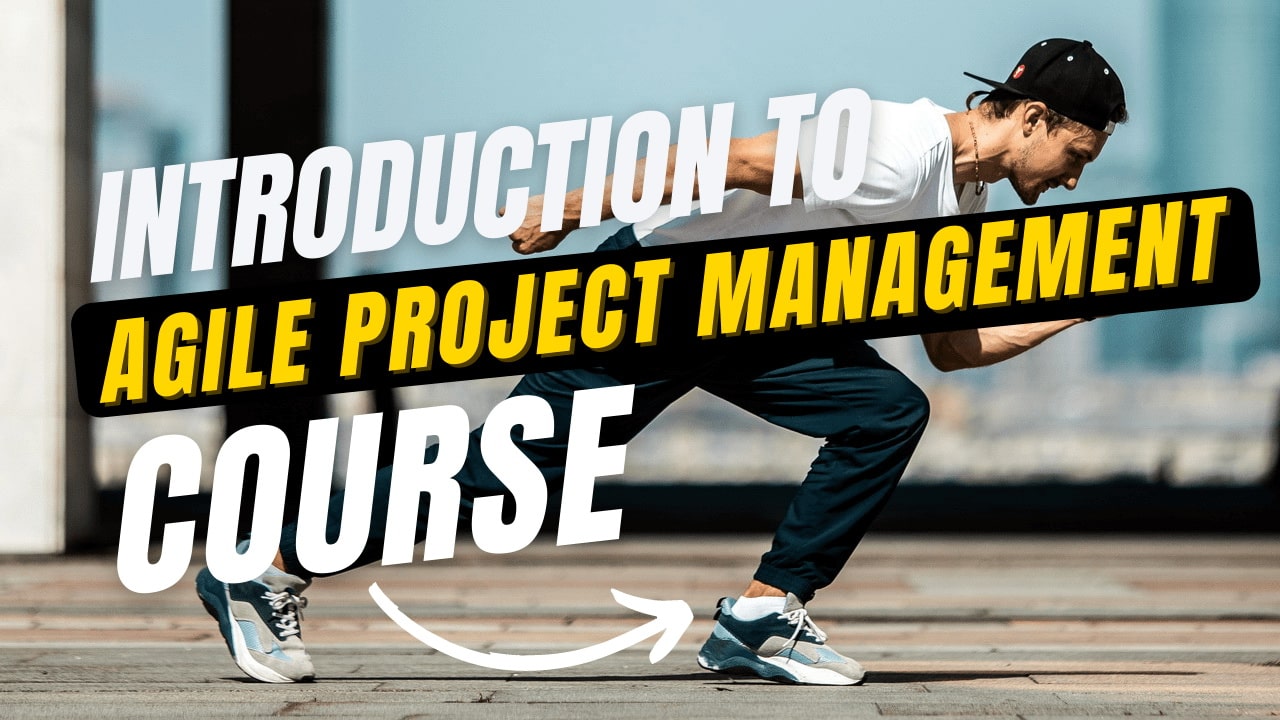Introduction to Agile Project Management
Hey there, fellow learners!
Welcome to the Introduction to Agile Project Management. I’m thrilled to start our Agile journey together and demystify this game-changer in project management for you.
I strongly recommend watching this video as it complements the content of this brief introductory course that accompanies this blog post.
Introduction to Agile Project Management – What is Agile Project Management?
Welcome to ‘Introduction to Agile Project Management.’
Now, let’s jump right in. Ever been on a project where things change overnight, leaving everyone puzzled? Frustrating, isn’t it? Well, that’s where Agile swoops in to save the day!
Agile Project Management is like having a superpower for managing projects flexibly and adaptively. It’s not a rigid set of rules; think of it more like a toolkit filled with strategies and principles that help teams respond to change faster and deliver value sooner. No more waiting for months to see results!
Click here for more information on how to fast-track your journey to becoming a Scrum professional.
Imagine you’re building a house. Instead of waiting until the entire house is done to make changes, Agile lets you adjust the plans as you go. Maybe you want a bigger kitchen or a cozier living room. Agile is all about welcoming change, collaborating with your team, and delivering small, valuable chunks of work regularly.
Origins of Agile and The Agile Manifesto
Now, let’s get a little historical. Picture this: it’s February 2001, in snowy Utah. A bunch of software developers gather at a ski resort, and they’re not there for the slopes. They’re there to change the world of project management.
This meeting gave birth to what’s known as the Agile Manifesto. It’s like the Declaration of Independence for Agile. It’s a short and sweet document that lays out four core values and twelve principles that guide the Agile way of working. It’s like their North Star, helping them navigate the world of uncertainty.
Agile Principles and Values
Alright, let’s take a closer look at those values and principles. They’re like the DNA of Agile.
Values like “Individuals and interactions over processes and tools” and “Customer collaboration over contract negotiation” emphasize the importance of people and communication in Agile. It’s not just about following a rulebook; it’s about connecting with your team and customers.
And those principles?
They encourage things like delivering software frequently, welcoming changing requirements, and maintaining a sustainable pace. It’s all about staying nimble and responsive.
Agile vs. Traditional Project Management
Now, I know you might be wondering, “How is Agile different from the old-school project management I’ve been doing?”
It’s a great question!
Traditional project management, like the Waterfall method, is like planning a cross-country road trip with every detail mapped out before you hit the road. You might end up with a flawless plan, but if you hit traffic, you’re stuck.
Agile, on the other hand, is more like a road trip where you have a rough idea of your destination, but you’re ready to change your route if you find a hidden gem along the way. It’s about adaptability and making the most of every twist and turn.
So, there you have it, the basics of Introduction to Agile Project Management. It’s all about flexibility, collaboration, and delivering value faster. It’s not just a methodology; it’s a mindset shift that can transform how you approach projects.

Overview of Agile Frameworks
Alright, think of Introduction to Agile Project Management as a scoop of your favorite ice cream. Just like ice cream starts with a common base and gets its unique flavors, Agile methodologies like Scrum, Kanban, and Lean bring their own special twist to managing projects.
Scrum Framework
Now, if Agile had a poster child, it would be Scrum. Picture this: a rugby team huddled together, passing the ball, and advancing down the field. Scrum in Agile is like that huddle—a short, focused team meeting where everyone coordinates their moves.
In Scrum, we have roles like the Scrum Master, Product Owner, and Development Team. It’s all about sprinting toward your project goals and scoring those touchdowns (well, metaphorical ones) regularly.
Kanban: Visualizing Work
Ever played with building blocks as a kid? Kanban is like that but for project management. You move tasks from “To Do” to “Doing” to “Done” on a visual board. It’s like seeing your progress right in front of you, and it’s super satisfying!
Kanban is all about maintaining a steady flow of work and minimizing bottlenecks. It’s like traffic management for your projects.
Lean: Maximizing Value
Okay, imagine you’re decluttering your room. You want to keep only the things that spark joy (thanks, Marie Kondo!). Lean in Agile is similar—it’s about minimizing waste and maximizing value.
Lean principles help you streamline processes, eliminate unnecessary steps, and focus on what truly matters to your customers. It’s like decluttering your project processes!
Choosing the Right Agile Approach
Now, here’s the kicker—how do you pick the right Agile approach for your project?
It’s like choosing the right outfit for an occasion. You wouldn’t wear a tuxedo to a beach party, right?
Selecting the right Agile methodology depends on factors like your project’s nature, size, and requirements. At times, Scrum may be the ideal choice; while other situations may call for Kanban. It’s all about staying flexible and choosing what aligns best with your needs.
Now, let’s embark on the next exciting phase of our Introduction to Agile Project Management journey – the Agile Project Lifecycle. Think of it as our roadmap for transforming ideas into reality. So, grab your compass, and let’s chart this course together!
Initiating Agile Projects
You know that feeling when you start a new adventure?
The excitement mixed with a touch of uncertainty?
Well, initiating Agile projects is a bit like that. It’s where you plant the seed of your project and watch it grow.
In this phase, we define our project’s vision, set goals, and assemble our Agile team. It’s the foundation, the moment you decide, “Hey, we’re going Agile for this!”
Planning in Agile
Now, let’s talk about planning. Remember planning a road trip with your buddies?
You chart out your destinations, estimate travel times, and decide where to stop for snacks. Agile planning is quite similar, but it’s done in smaller, bite-sized chunks.
Agile planning involves creating a backlog of tasks, setting priorities, and scheduling short, focused periods called sprints. It’s like planning mini-road trips within your big journey. You tackle one sprint at a time, ensuring you’re on the right path.
Executing Agile Projects
Ah, the execution phase! It’s like hitting the road on that epic road trip. You’ve got your plans, and your team, and now it’s time to make things happen.
In Agile, we work collaboratively, breaking down tasks into manageable pieces. Each day, we gather for a quick check-in (the Daily Scrum) to ensure everyone is on track. It’s all about teamwork and steady progress, just like a smooth road trip.
Monitoring and Controlling Agile Projects
Have we ever had to make detours on a road trip due to unexpected road closures?
Agile projects are no different. Things change, and that’s okay. In this phase, we keep an eye on our progress and make adjustments as needed.
Regular sprint reviews and retrospectives are like pit stops for reflection and improvement. We’re constantly fine-tuning our route to reach our destination faster and more efficiently.
Closing Agile Projects
Finally, we reach the end of our journey—the closing phase. It’s time to wrap things up, celebrate our achievements, and say farewell (until the next adventure).
In Agile, we deliver a working product incrementally, so you don’t wait until the very end to unveil it. Customer feedback is valued throughout the journey, ensuring the final product is spot on.
Conclusion
If you haven’t already watched the video at the beginning, feel free to do so. It’s a great companion to Introduction to Agile Project Management.
We’ve been on quite an adventure together, and I’m thrilled to share what’s waiting for you as we continue this journey in the world of Introduction to Agile Project Management.
As we venture further, you’ll get acquainted with the folks who make Agile tick—Product Owners, Scrum Masters, and amazing Developers. Think of them as the star players on your favorite sports team, each bringing their unique skills to the game.
Then, we’ll delve into the heart of Agile—the ceremonies and artifacts that keep the Agile engine humming. Sprint planning, daily scrums, and all those other rituals are like the secret sauce that spices up your favorite dish.
But it doesn’t stop there!
Our Agile toolkit is brimming with tools and techniques to make your Agile projects shine. Task boards, user stories, and agile estimation techniques are like your trusty Swiss Army knife, ready to tackle any challenge.
Scaling Agile is another exciting phase of the Agile journey. Imagine your favorite band playing at a sold-out stadium—scaling Agile is like that, but for project management.
As we progress in our journey with Introduction to Agile Project Management, we’ll immerse ourselves in real-life Agile scenarios. We’ll explore how organizations wholeheartedly embrace Agile and equip you with the skills to overcome any challenges that might crop up. These are the stories and lessons that will help you emerge as a true Agile champion.
As you continue your journey with Introduction to Agile Project Management, we’ll delve into what lies beyond—opportunities for further education, certification options, and forging a fulfilling career in Agile. Plus, you’ll have the chance to connect with a fantastic community of fellow Agile enthusiasts who share your passion.
So, my friend, gear up for the amazing adventure ahead! I’m eagerly looking forward to our continued exploration of Agile together.
To take your Agile expertise even further, don’t forget to check out my Free Scrum Course. It’s another step toward becoming an Agile superstar!
Keep that Agile spirit burning bright, and I’ll see you inside the Free Course.
